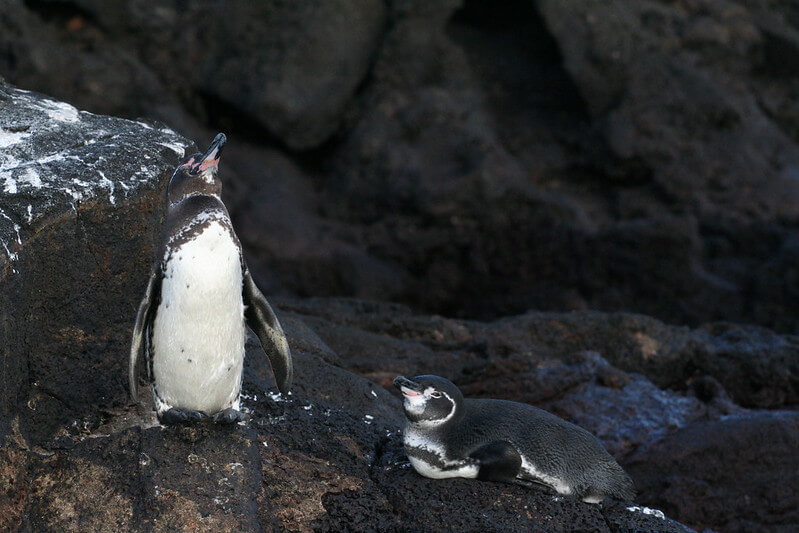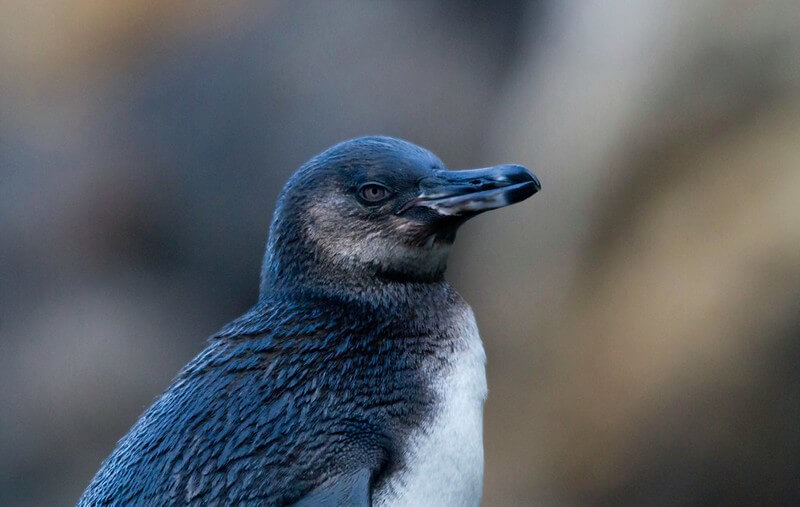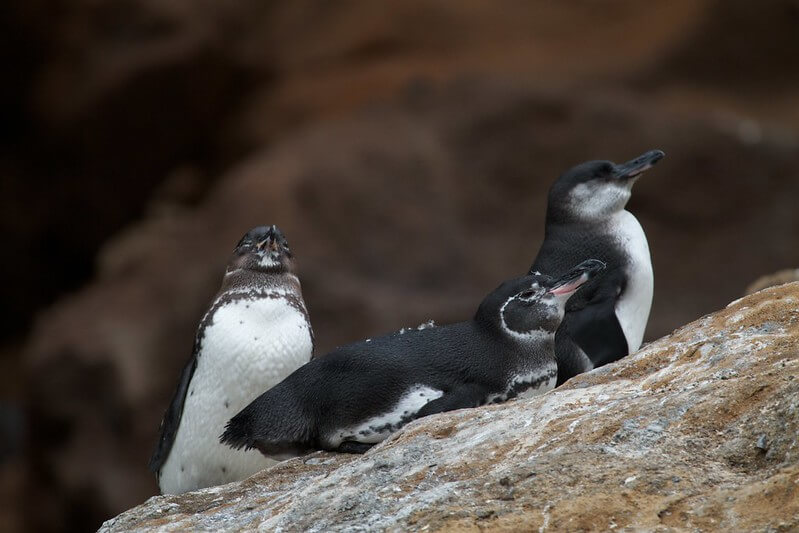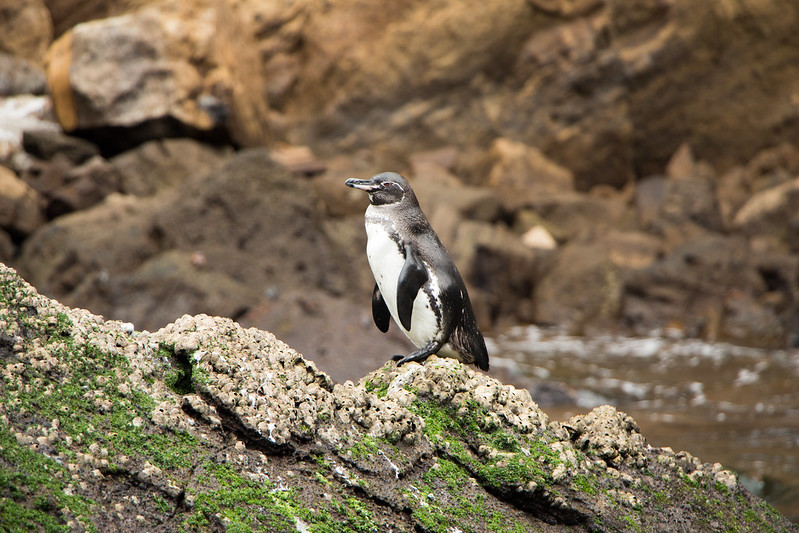When thinking about the Galapagos Islands the mind usually gravitates toward strange and unique animal species but it’s pretty uncommon that you would immediately think of penguins since the Galapagos Islands rests right on the equator making it too far north for penguins to thrive, right?
Wrong! The Galapagos Islands is home to the second smallest penguin species in the world, the Galapagos penguin!
Besides their original location, there are a lot of things that make this species unique and that’s why today I will share with you 12 Galapagos penguin facts.
Let’s dive right in!
1. The Galapagos Penguin Is The Smallest In South America
The Galapagos penguin is the smallest penguin species in South America, the smallest out of the “banded penguins” (genus: Spheniscus), and the second smallest penguin in the world.
This small marine bird stands at a height of around 53 cm / 21 in. and weighs between 1.7 – 2.5 kg / 3.7 – 5.5 lbs.
The only sexual dimorphism displayed by this species is that males are slightly larger than females.
2. The Galapagos Penguin Is The Only Species Living Close To The Equator
The Galapagos penguin is found further north than any other penguin species. It is also the only penguin that crosses over to the northern hemisphere as part of the population inhabits the northern tip of Isabela island which is right above the equatorial line.
3. The Galapagos Penguin Is Endemic To The Galapagos Islands
While the Galapagos penguin is closely related to the other “banded penguins” (Humboldt, African, and Magellanic) this particular species is endemic to the Galapagos Islands which means that it is not found anywhere else in the world.

4. The Galapagos Penguin Is Endangered
Due to the extremely limited range inhabited by the Galapagos penguin, its population is highly vulnerable.
This species is currently listed as “endangered” by the IUCN (International Union for the Conservation of Nature) which means it is facing a very high risk of extinction in the wild.
In fact, according to recent scientific predictions, there is a 30% chance that the Galapagos penguin will go extinct within the next 100 years.
The Galapagos penguin population was tragically, and significantly, reduced during 2 different “El Niño” events (a 75% reduction in the year 1982/1983 and then a 65% reduction in 1997/98).
Currently, there are only about 1,200 mature individuals and, according to the IUCN, the population is “decreasing”.
Besides the weather alterations brought on by natural phenomena such as “el Niño”, the Galapagos penguin also faces other threats, many of them directly related to human activity such as:
- Food availability because of overfishing and climate change.
- Loss of habitat and nesting grounds to human encroachment.
- Invasive predatory species like rats, and domestic cats and dogs.
- Falling victim to bycatch.
5. The Galapagos Penguin Doesn’t Migrate
Migration occurs when, due to environmental factors, a certain area doesn’t meet an animal’s needs and it must move to one that does.
For example, changes in temperature result in the reduction of food availability and/or excessive heat or cold.
Countries located on the equator, or very close to it, experience very climate variations and are usually always warmer and lack seasonal weather changes.
For this reason, the Galapagos penguin has no need to migrate.
As a general rule of thumb, the farthest a penguin is from the equator the most likely it is to migrate. However, all penguins have the skills necessary for migration, including the Galapagos penguin.
6. The Galapagos Penguin Molts Twice A Year
Molting is crucial for all penguin species as when feathers grow old and worn, they lose their waterproof qualities, which are essential for any penguin.
Molting, however, is a particularly tolling event for penguins, so much it is actually referred to as “catastrophic molt” because instead of doing it little by little, a penguin will drop all its feathers at once which means it can’t go on foraging dives for the duration of the molt and must therefore fast.

Out of the 18 penguin species, 17 of them molt once a year but the Galapagos penguin will actually go through 2 molts per year, each lasting around 13 days.
The reason for this is that because of the hot weather and the intense sun its feathers get worn pretty quickly.
7. The Galapagos Penguin Chicks Have Built-In Sunblock
Sunshine in the Galapagos islands can get quite intense, which might be a dream come true for your regular beachgoer looking to get a killer tan, however, this is certainly not the case for the Galapagos penguin.
Chicks of this species have unique feathers that protect them from the sun. These feathers are brown on top, to prevent sunburn, and white on the bottom to prevent overheating.
8. The Galapagos Penguin Doesn’t Have Feathers On Its Legs
While there are 2 cold ocean currents (Humboldt and Cromwell) that keep the water surrounding the Galapagos Islands at a cooler temperature the Galapagos Penguin has several behaviors and physical adaptations that keep it from overheating.
One of those adaptations is the lack of feathers on its legs.
9. The Galapagos Penguin Has An Elaborate Courtship Ritual
There is a series of complex behaviors that take place before a Galapagos penguin couple mates. The first step is of course finding a mate.
This penguin is monogamous so once a partner has been found it’s likely that this step can be skipped in the future.
However, mated couples will still display courtship behaviors as a way to strengthen their bond.
Some of these courtship rituals are grooming, wing patting, and rubbing their bills together. After these displays, the penguin couple will build a nest together. Once the nest is ready copulation takes place.
10. The Galapagos Penguin Has 3 Breeding Cycles Per Year
Since this penguin doesn’t migrate they will breed year-round whenever the water is cool enough to have abundant prey.
A female will produce 2 eggs per clutch but usually will only raise 1 chick.
11. The Galapagos Penguin Has Complex Communication
The Galapagos penguin has many different vocalizations but also relies heavily on body language.
In fact, when advertising relationship status (mated or unmated) this penguin will use different body postures instead of just vocalizing.

12. The Galapagos Penguin Can Live For Up To 20 Years
The estimated life expectancy of the Galapagos penguin is 15 – 20 years. Nonetheless, due to predation, disease, and human-induced threats, it is rare that one would make it to such an age.
I am a lover of everything nature and animal related with over 15 years of experience in the field of wildlife rescue and education. Currently living in Colombia working with wild and domestic animals and spending all my free time writing about them 🙂

